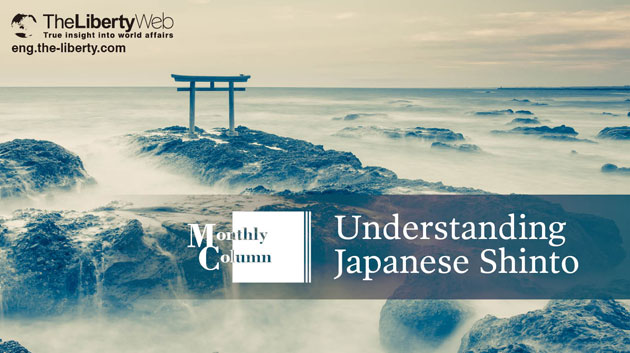Understanding Japanese Shinto
Editor’s Column
Japan’s Shinto Is a World Religion
The 70th anniversary of the end of WW2 began with calm, yet it has become clear which countries refuse to reevaluate their historical perspectives on the war.
When Prime Minister Shinzo Abe once again announced his intention to present a new Prime Minister’s Statement in a press conference, the U.S. Press Secretary immediately requested the Japanese government instead to follow the old Kono/Murayama Statements; while China and South Korea have merely endorsed the American position, the main driver of the narrative continues to be the U.S.
This may be natural seeing as Japan and America were in conflict for 4 1/2 years. Throughout this period, the Americans had thought that a ‘savage people with a savage religion began invading surrounding nations. This narrative seems to continue in their minds to this day.
On the other hand, the Americans have acted surprised, from time to time, about the moral national character of the Japanese people. When the Great East Japan Earthquake hit in 2011, the American media continually reported their astonishment over how looting and riots weren’t occurring, and how the needy were able to line-up in an orderly fashion and the manner in which they still gave way to others in the relief service lines. To the Japanese, it was a common sight, but to foreign onlookers, it appeared to be something of a miracle.
Around 50 years before the Pacific War, Japan succeeded in a bloodless revolution, and it became the first non-Western country to establish a modern state; the international community also reflected on that outcome as a miracle. However, according to America’s flawed narrative, the Japanese ‘suddenly’ turned into demons during the war, and ‘suddenly’ became moral once more after it had ended.
Early Shinto Believers in Japan Knew that They Were Connected to the “World’s God”
What Is the True Face of Japan?
In his recent book, “The Theory of Happiness in Shinto”, Master Ryuho Okawa of Happy Science decoded the true nature of Shintoism. In it, he posited Shintoism’s potential as a world religion, explaining that an ancient document written in an ancient script called “Hotsumatsutae” described Amemioya-no-kami as the creator of heaven and earth.
“This is why”, Master said, “I cannot easily accept a theological theory that claims that the Japanese were savages at the time. If we look further, I think that it denotes, not only a sense of nationalism, but also one of a connection with a world God.”
Researchers have suggested that the “Hotsumatsutae” was written around 110 CE, 600 years before the Kojiki and Nihon Shoki (two major ancient Japanese records). In these accounts, the universe had already been in existence, prior to the sudden appearance of gods such as Ame-no-minakanushi and Kuni-no-kotachi, but in the “Hotsumatsutae” Amemioya-no-kami’s creation of the universe is described as follows:
Amemioya created a large pot with his breath, and in it, a transparent pillar. A light, circled around a pillar, and from here, Yin and Yang were born. Yin became the Sun, and Yang became the Earth and Moon.
Amemioya and Elohim as Gods of Mercy
Amemioya then created humanity. He used a large pillar to transport souls from the higher world down to earth, and watched over the inhabitants as they experienced their cycles of reincarnation. Records document Amemioya as one such God of Mercy.
Since the Judeo-Christian Old Testament also describes a Creator, the question arises as to whether they are the same as or different from Amemioya. In Genesis 1 of the Old Testament, God creates the heavens, Earth, plants, and animals through his Word. He then forms man in his own image. It is recorded that here, the world was enveloped in light and that humans were good.
In Chapter 2, a change comes about, and a dark shadow looms. God creates Adam from the dust of the Earth, and forms Eve from Adam’s rib. God puts a curse on both of them for eating the forbidden fruit, and exiles them from the Garden of Eden. This is the origin of human sin.
Taking a closer look at the Old Testament, it can be seen that in Chapter 1 of Genesis, God is referred to as Elohim, and in Chapter 2, he is called Yahweh. It has been interpreted that these two names signify two distinct facets of God’s character, but many scholars dispute this idea, positing that they were in fact two completely different gods. That is, Elohim was the supreme God of Love that people in in the Middle East and Africa worshipped, while Yahweh was the national God of Judgment that the Israelites worshipped; and Yahweh became angry every time the Israelites worshipped a different god.
Both Amemioya and Elohim were fathers to the souls of mankind, and both were filled with mercy. It is highly probable that the “Hotsumatsutae” and the Old Testament were records of faith towards the same God.
The name of the Islamic god, ‘Allah’, developed from ‘Elohim’ and thus Islam believes in the same God as Judaism and Christianity. What is more, we now see that Japanese Shintoism also follows that same God, which is a remarkable discovery.
Japanese Shintoism has the potential to become a world religion. It is beyond doubt that Shintoism is not a savage or demonic religion.
The Miracles, High Morals, and Religious Harmony of Japan
On the contrary, the Shinto faith has inspired many miracles.
The Japanese behavior, displayed at the Great East Japan Earthquake, is one that Shintoism heavily influenced. It is commonly said that Shinto does not have any teachings, but in his recent book “An Overview of Religious Sociology”, Master Okawa condensed the teachings of Shinto into 3 points: washing away all impurities as part of a purification process, shaping the mind that treasures harmony, and encouraging the Bushido spirit to fight in the name of justice. These traditions are present at the base of Japanese morality, and it was the cause of people to be polite and helpful to each other during the Earthquake.
Another miracle of world history was how Japan was able to maintain Shintoism while simultaneously accepting Buddhism, thus sustaining religious harmony.
Usually, if a country accepts a foreign religion, the national and traditional religions of that country perish. The Germanic peoples, who completely converted to Christianity, are a prime example.
Prince Shotoku accepted Buddhism as the nation’s religion while still keeping the framework of Shintoism. Emperor Kanmu built the religious capital, Heian-kyo, to maintain the harmony between various religions such as Shintoism, Buddhism, and Taoism. The city served as the country’s capital for over 1,000 years, and there have been no other examples of such religious harmony in the history of mankind.
It is often said that Shintoism was a tolerant polytheistic religion that helped this to happen, but the reason why Shintoism did not disappear was its potential ability to function as a world religion.
An Imperial-led Modernization
The Meiji modernization of Japan is indebted to Shintoism for its miraculous turnout. At the time, the great world powers of Europe and America were invading Asia. In order to repel them, Japan quickly learnt Western natural sciences and technology, and thus prepared modern industries and armaments. What deserves recognition is that the Emperor stepped forward and enthusiastically pursued this modernization route. Being able to maintain Japan’s traditional religious culture while absorbing much from the Christian civilizations was perhaps due to the influence of Shinto.
Japan Realized Its ‘World under One Roof’ Ideology, Freeing Asia from Colonial Rule
Arguably, Japan’s greatest miracle was the liberation of Asia and Africa from Colonial rule. In the latter half of the 19th century, the apartheid that continued in South Africa until the 1990s was slowly spreading throughout the world. Here, Japan stood up and fought long and hard to eradicate this ideology. It succeeded in liberating the European and American colonies, but as a consequence, Japan also faced destruction.
After WW2, many countries became independent and ended the age when white people had the power to use race as an excuse to dominate the world.
During WW2, Japan declared the slogan ‘The World under One Roof’. In the post-WW2 period, it was misinterpreted to imply a pro-invasion stance, but in truth, it meant for the world to live happily as one big family; it championed peace and prosperity. The slogan was derived from words the First Emperor of Japan, Emperor Jinmu, spoke at his coronation to ensure peacekeeping among his people. In fighting the Greater East Asia War, Japan looked to the founding principles of the country, upholding that whether one is white or black or yellow, everyone is equal.
Can the Japanese Continue To Be the People of Miracles?
There is a possibility for the Japanese to bring about an even greater miracle. Master Ryuho Okawa has awakened to his identity as the core consciousness of the supreme God, El Cantare, the God of Creation described in the Holy Bible and “Hotsumatsutae”, and has proclaimed his goal, universal salvation.
While Japan imported aspects of Western civilization in the Meiji era, from now on, it is Japan that should shoulder the responsibility of becoming a global role model for the coming civilization. The political scientist Samuel Huntington advanced that Japan was one of the main independent civilizations of the world – along with the Western, Islamic and Sinic – and held that Japan had the role to mediate the friction between Islam and the West.
In this issue, a special article titled “The Path to Eradicating Islamic Terrorism” explains the route to this reconciliation. In it, Master Okawa gives reasons why his teachings will end wars between religions and will guide the world to further prosperity.
The Japanese have been known as a people of miracles. Will they be able to continue to be so? That choice is is being posed to each and every Japanese person.



















